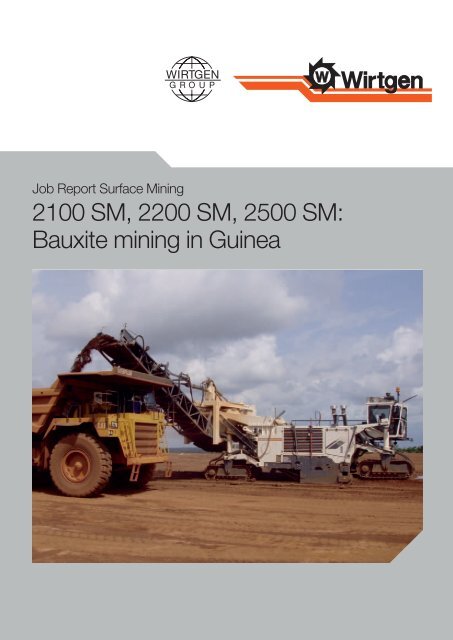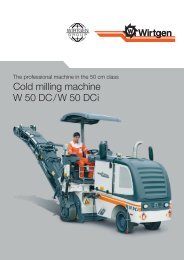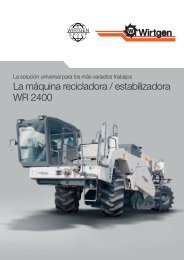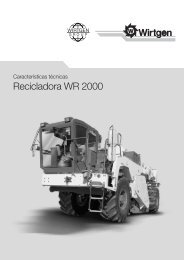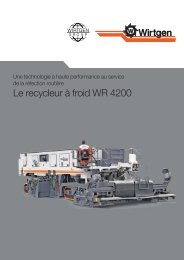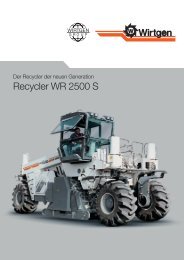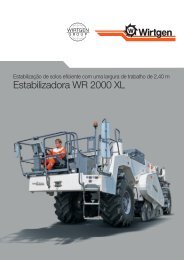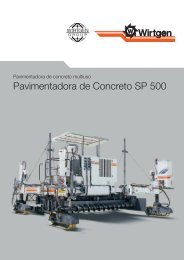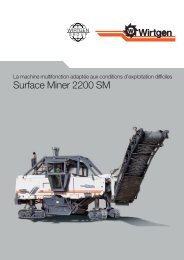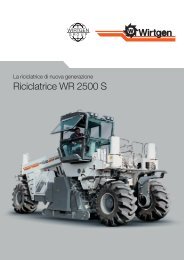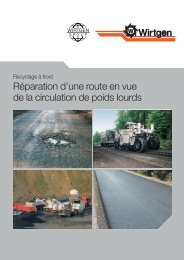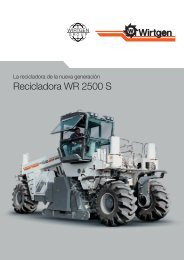2100 SM, 2200 SM, 2500 SM: Bauxite mining in ... - Wirtgen GmbH
2100 SM, 2200 SM, 2500 SM: Bauxite mining in ... - Wirtgen GmbH
2100 SM, 2200 SM, 2500 SM: Bauxite mining in ... - Wirtgen GmbH
You also want an ePaper? Increase the reach of your titles
YUMPU automatically turns print PDFs into web optimized ePapers that Google loves.
Job Report Surface M<strong>in</strong><strong>in</strong>g<br />
<strong>2100</strong> <strong>SM</strong>, <strong>2200</strong> <strong>SM</strong>, <strong>2500</strong> <strong>SM</strong>:<br />
<strong>Bauxite</strong> <strong>m<strong>in</strong><strong>in</strong>g</strong> <strong>in</strong> Gu<strong>in</strong>ea
<strong>Wirtgen</strong> Surface M<strong>in</strong><strong>in</strong>g:<br />
<strong>2100</strong> <strong>SM</strong>, <strong>2200</strong> <strong>SM</strong>, <strong>2500</strong> <strong>SM</strong>: <strong>Bauxite</strong> <strong>m<strong>in</strong><strong>in</strong>g</strong> <strong>in</strong> Gu<strong>in</strong>ea<br />
Bernhard Schimm, January 2005<br />
Surface M<strong>in</strong><strong>in</strong>g technology is <strong>in</strong>troduced <strong>in</strong> bauxite m<strong>in</strong>es<br />
How is it possible to <strong>in</strong>crease the exploitation of bauxite<br />
deposits? This was the central question bauxite m<strong>in</strong>e operators<br />
<strong>in</strong> Gu<strong>in</strong>ea raised <strong>in</strong> the late 90s. In the Tsentralnaya<br />
ore body section of the Debele M<strong>in</strong>e some ore pillars were<br />
left over <strong>in</strong> the vic<strong>in</strong>ity of a generator substation and along<br />
a public road and a railway l<strong>in</strong>e. In this area blast<strong>in</strong>g was of<br />
course prohibited. The reserve of these pillars was estimated<br />
to be around 89,000 t. Further locations with similar conditions<br />
had been identified. The m<strong>in</strong>e owner, Kompanyia<br />
Boksity K<strong>in</strong>dii Co. Ltd., decided <strong>in</strong> 2000 to purchase a<br />
<strong>Wirtgen</strong> Surface M<strong>in</strong>er <strong>2100</strong> <strong>SM</strong> for the blast-free removal<br />
of these sections. Dur<strong>in</strong>g October 2000 the <strong>2100</strong> <strong>SM</strong> started<br />
the operation <strong>in</strong> the Tsentralnaya ore body. In n<strong>in</strong>e and a half<br />
months time, i.e. after approximately 3,000 work<strong>in</strong>g hours,<br />
this mach<strong>in</strong>e m<strong>in</strong>ed 300,000 t of bauxite and 25,000 t of<br />
overburden.<br />
Dur<strong>in</strong>g the year 2001 the CGG company bought a second<br />
mach<strong>in</strong>e, a <strong>2200</strong> <strong>SM</strong> <strong>Wirtgen</strong> Surface M<strong>in</strong>er. In November<br />
2001 this mach<strong>in</strong>e started the operation <strong>in</strong> the Tsentralnaya<br />
ore body. After three months time, i.e. after approximately<br />
900 work<strong>in</strong>g hours, the <strong>2200</strong> <strong>SM</strong> m<strong>in</strong>ed 95,000 t of bauxite<br />
and 20,000 t of overburden.<br />
In both cases the <strong>Wirtgen</strong> Surface M<strong>in</strong>ers operated on<br />
narrow faces with lengths of less than 100 m to 160 m and<br />
widths rang<strong>in</strong>g from 35 to 55 m. Common road trucks with<br />
an average load<strong>in</strong>g capacity of 16 t were loaded with the<br />
m<strong>in</strong>ed material. Some rock samples tested showed a<br />
compressive strength of 30 to 125 MPa. The compressive<br />
strength to tensile strength ratio ranged from 5 to 7. This<br />
<strong>in</strong>dicated that the material is of a tenacious nature. Depend<strong>in</strong>g<br />
on the hardness of the rock, cutt<strong>in</strong>g performances ranged<br />
from 140 to 550 t/h. The average cutt<strong>in</strong>g performance was<br />
<strong>in</strong> the range of 250 t/h. However rock with different types of<br />
The direct load<strong>in</strong>g of the cut material facilitates the operational processes <strong>in</strong> open-cast <strong>m<strong>in</strong><strong>in</strong>g</strong>.
Surface M<strong>in</strong>ers conv<strong>in</strong>ce through their ability to selectively m<strong>in</strong>e the<br />
respective material.<br />
Surface M<strong>in</strong>ers are able to m<strong>in</strong>e materials with vary<strong>in</strong>g hardness<br />
without <strong>in</strong>terrupt<strong>in</strong>g the <strong>m<strong>in</strong><strong>in</strong>g</strong> process.<br />
hardnesses could be cut without <strong>in</strong>terrupt<strong>in</strong>g the <strong>m<strong>in</strong><strong>in</strong>g</strong><br />
process. Up to March 2003 nearly 1 million t of bauxite ore<br />
from the reserve’s abandoned zones, where drill<strong>in</strong>g and<br />
blast<strong>in</strong>g processes were not allowed, had been extracted<br />
by means of <strong>Wirtgen</strong> Surface M<strong>in</strong>ers.<br />
Surface M<strong>in</strong>ers at work <strong>in</strong> the Frija ore deposit<br />
The economical blast-free and clean removal of bauxite and<br />
the production of small particle sizes, along with the elim<strong>in</strong>ation<br />
of the crush<strong>in</strong>g process, conv<strong>in</strong>ced the bauxite m<strong>in</strong>e<br />
operators of the strengths of the <strong>Wirtgen</strong> Surface M<strong>in</strong><strong>in</strong>g<br />
technology. Apart from <strong>m<strong>in</strong><strong>in</strong>g</strong> out blocked bauxite from<br />
areas <strong>in</strong> which blast<strong>in</strong>g is prohibited, the Surface M<strong>in</strong><strong>in</strong>g<br />
technology was also considered for the use <strong>in</strong> the general<br />
<strong>m<strong>in</strong><strong>in</strong>g</strong> process at the Frija ore deposit.<br />
Up to 2003 bauxite from this m<strong>in</strong>e had been m<strong>in</strong>ed by conventional<br />
methods us<strong>in</strong>g drill<strong>in</strong>g and blast<strong>in</strong>g. However the<br />
very complex deposit structure made it very difficult to reach<br />
the required raw material quality. The Frija ore deposit consists<br />
of five ore zones, each of them has 3 to 7 seams. The<br />
respective seams thickness ranges from 2 to 12 m. The ore<br />
seams conta<strong>in</strong> substantial <strong>in</strong>clusions of low grade bauxite<br />
with less than 37%. Therefore the ore is m<strong>in</strong>ed from several<br />
pits to reach the required average ore quality.<br />
The <strong>2200</strong> <strong>SM</strong> was shifted to this deposit <strong>in</strong> April 2003 and is<br />
now used for the selective <strong>m<strong>in</strong><strong>in</strong>g</strong> of bauxite <strong>in</strong> the difficult<br />
geological sections described. The mach<strong>in</strong>e dumps the cut<br />
material on the ground and builds up a m<strong>in</strong>e stockpile. The<br />
material is later picked up on demand by front-end loaders<br />
and loaded onto trucks with a load<strong>in</strong>g capacity of 100 t. In<br />
2003 414,000 t have been m<strong>in</strong>ed selectively out of the total<br />
production of 2,308,000 t. The average production rate per<br />
motor hour of the mach<strong>in</strong>e was 180 t/h.<br />
Plann<strong>in</strong>g a production expansion the m<strong>in</strong>e decided to purchase<br />
a <strong>2500</strong> <strong>SM</strong> Surface M<strong>in</strong>er. Beside their ability of selective<br />
<strong>m<strong>in</strong><strong>in</strong>g</strong>, the m<strong>in</strong>e was able to elim<strong>in</strong>ate the expansion<br />
of their crush<strong>in</strong>g plant s<strong>in</strong>ce the particle size produced by<br />
the <strong>Wirtgen</strong> Surface M<strong>in</strong>ers elim<strong>in</strong>ates primary crush<strong>in</strong>g.<br />
The <strong>2500</strong> <strong>SM</strong> was commissioned <strong>in</strong> July 2004. Dur<strong>in</strong>g the<br />
commission<strong>in</strong>g phase this mach<strong>in</strong>e reached a cutt<strong>in</strong>g performance<br />
of 500 t/h on average. Consider<strong>in</strong>g truck change<br />
and manoeuver<strong>in</strong>g times the real production rate is 360 t/h<br />
on average.<br />
Dur<strong>in</strong>g 4 years of operation the various models of <strong>Wirtgen</strong><br />
Surface M<strong>in</strong>ers have become a proven technology for<br />
bauxite <strong>m<strong>in</strong><strong>in</strong>g</strong> <strong>in</strong> Gu<strong>in</strong>ea.<br />
This technology is an economical solution for:<br />
Blast-free <strong>m<strong>in</strong><strong>in</strong>g</strong> of bauxite.<br />
M<strong>in</strong><strong>in</strong>g of materials with vary<strong>in</strong>g hardness without<br />
<strong>in</strong>terrupt<strong>in</strong>g the <strong>m<strong>in</strong><strong>in</strong>g</strong> process.<br />
Selective <strong>m<strong>in</strong><strong>in</strong>g</strong> of different bauxite qualities.<br />
Elim<strong>in</strong>ation of primary crush<strong>in</strong>g.<br />
2// 3
Illustrations are without obligation. Subject to technical changes.<br />
Performance data depend on operational conditions. No. 20-49 EN-01/06 © by <strong>Wirtgen</strong> <strong>GmbH</strong> 2006. Pr<strong>in</strong>ted <strong>in</strong> Germany<br />
<strong>Wirtgen</strong> <strong>GmbH</strong><br />
Hohner Str. 2 · 53578 W<strong>in</strong>dhagen · Germany<br />
Phone: +49 (0) 26 45 / 131-0 · Fax: +49 (0) 26 45 / 131-242<br />
Internet: www.wirtgen.com · E-Mail: <strong>in</strong>fo@wirtgen.com


